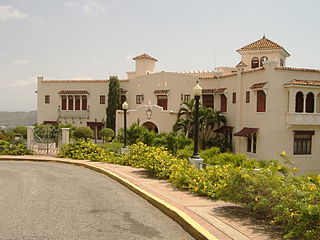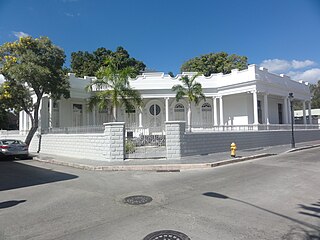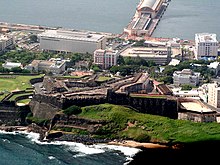
Castillo Serrallés is a mansion located in the city of Ponce, Puerto Rico, overlooking the downtown area. It was built during the 1930s for Juan Eugenio Serrallés, son of businessman Juan Serrallés, founder of Destilería Serrallés. The structure sits on a 2.5-acre (1.0 ha) exceedingly manicured property. Nowadays, the structure functions as a museum, Museo Castillo Serrallés, with information about the sugar cane and rum industries and its impact in the economy of Puerto Rico. It is also increasingly used as a venue for social activities, including destination weddings. The property was listed in the National Register of Historic Places in 1980. In 1996, the structure was featured in the American TV series America's Castles.
José "Pepe" Díaz and Francisco Díaz were two cousins who served as Sergeants in the Toa Alta Militia. Both cousins helped defeat Sir Ralph Abercromby and defend Puerto Rico during an invasion in 1797.

The Antiguo Casino de Ponce, or simply the Casino de Ponce, is a historic structure, built in 1922 and located in Barrio Cuarto, Ponce, Puerto Rico. Originally built as a social club for Ponce's elite, it is currently used as the premier reception center of "The Noble City of Puerto Rico". The building, designed by Agustin Camilo Gonzalez in the Second Empire and Neo-Rococo styles, has a French facade and tones. It was listed in the National Register of Historic Places on 28 October 1987. It is located at the corner of Marina and Luna streets. The building has been called "an icon of Ponce's architecture, history, and identity." It is owned and administered by the Ponce Municipal Government. In 1936, during the Great Depression, the Casino declared bankruptcy and shut down. It subsequently had various uses: a postal office, a public health unit, tax collector's office, and even a temporary city hall. In 1990 it was restored by the Ponce Municipal Government, and has since been used for high-ranking official municipal business. For example, it was here where the dinner to honor Prince of Asturias, His Majesty Felipe de Borbon, took place.

Eduardo Neumann Gandía, was one of Puerto Rico's most accomplished historians. He is particularly well known for his nineteenth century book Verdadera y Auténtica Historia de la Ciudad de Ponce: desde sus primitivos tiempos hasta la época contemporánea. His father was Guillermo Neumann, who was mayor of Ponce from 23 April 1851 to 30 September 1851. Eduardo Neumann Gandía's most important work was Benefactores y Hombres Notables de Puerto Rico.. Neumann wrote profusely during a period of 30 years, producing some 20 major works plus numerous articles in newspapers and periodicals.

The Iglesia de la Santísima Trinidad was organized by British residents in Ponce, Puerto Rico, as an Anglican congregation in 1869. They built their first church of wood and metal at this site in 1873, aided by materials sent by Queen Victoria's government, including a bell cast in England in 1870. Located at the intersection of Marina, Mayor, and Abolicion streets, it was the first Anglican church built on the island. Holy Trinity was still the only Protestant church in Puerto Rico at the time of the United States invasion in 1898.

Albergue Caritativo Tricoche or Hospital Tricoche is a historic building located on Calle Tricoche street in Ponce, Puerto Rico, in the city's historic district. It was designed by the Spanish Royal Corps of Engineers. The architecture consists of 19th-century civil architecture. When built in 1878, "it held the top spot among public building in Puerto Rico," based on its size and beauty.

The Antiguo Cuartel Militar Español de Ponce or "El Castillo" is the only structure directly related to the events of the land defense of Puerto Rico during the 1898 American invasion of the Island. The historic building dates from 1894 and is located on Calle Castillo in Ponce, Puerto Rico, in the city's historic district. The structure was listed on the U.S. National Register of Historic Places on 14 May 1987.

The Antiguo Hospital Militar Español de Ponce is a historic building in Ponce, Puerto Rico, in the city's historic district. The building dates from 1896 or 1897. It was designed by the Spanish Royal Corps of Engineers. The architecture consists of 19th Neoclassical architecture style. The building is of architectural significance since it is the only one-story building of this style remaining in the city of Ponce and one of the best examples on the Island. Completed in 1897, the year before the Spanish–American War of 1898, this building was the last major construction undergone by the Spanish Government in the Americas. From 1905 to the mid 1970s the structure served as the Asilo de Ciegos de Ponce. As of 2020 the building sits abandoned.

Ponce Creole is an architectural style created in Ponce, Puerto Rico, in the late 19th and early 20th century. This style of Puerto Rican buildings is found predominantly in residential homes in Ponce that developed between 1895 and 1920. Ponce Creole architecture borrows heavily from the traditions of the French, the Spaniards, and the Caribbean to create houses that were especially built to withstand the hot and dry climate of the region, and to take advantage of the sun and sea breezes characteristic of the southern Puerto Rico's Caribbean Sea coast. It is a blend of wood and masonry, incorporating architectural elements of other styles, from Spanish Revival to Victorian.

Casa Oppenheimer is a historic house in Ponce, Puerto Rico, designed in 1913 by famed Puerto Rican architect Alfredo B. Wiechers. The house is unique among other historic structures in historic Ponce for its skillful incorporation of front gardens in a very limited urban space. The historic building is located at 47 Salud Street, in the city's historic district, at the northwest corner of Salud and Aurora streets. The house is also known as Casa del Abogado. In April 2019, the house was turned into Casa Mujer by MedCentro, a women's health business concern.
Francisco Vassallo was Mayor of Ponce, Puerto Rico, in 1820 and 1832.

Ramón Marín Solá was a nineteenth-century Puerto Rican educator, journalist, politician, historian, poet, and playwright. He is best remembered for his 1875 historical masterpiece, "Las fiestas populares de Ponce."
Pedro Adolfo de Castro (1895–1936) was a twentieth-century architect from San Juan, Puerto Rico.

Museo Castillo Serrallés, a.k.a. Museo de la Caña y el Ron, is an agricultural museum in the city of Ponce, Puerto Rico, that showcases the history of sugar cane, its derivative rum industry, and their impact in the economy of Puerto Rico. The most notorious feature of the museum is the building it occupies. The building is a large four-story structure built in the 1930s for the owner of Ponce's Destileria Serralles, one of Puerto Rico's largest rum distilleries. The distillery was once also home to Puerto Rico's largest sugar-factory called Central Mercedita, producers of the Snow White sugar brand. The building, known as Castillo Serrallés, was designed by Pedro Adolfo de Castro in 1930 in the Spanish Colonial Revival style.
The following is a timeline of the history of the city of Ponce, Puerto Rico.
Juan Prats was Mayor of Ponce, Puerto Rico, twice in 1849. He was a landowner, owning—among others—Hacienda La Matilde, in Ponce. He was also an appraiser, best known for the contentious appraisal of the plot of land where the Ponce City Hall was built.

Cerro del Vigía is a hill in the municipality of Ponce, Puerto Rico, located just north of the city of Ponce. A tourist destination, it is home to Museo Castillo Serrallés, Cruceta del Vigía, and the former Hotel Ponce Intercontinental.
Carlos Cabrera y Martínez was interim Mayor of Ponce, Puerto Rico, from 1 November 1866 to 19 December 1866. He was interim mayor, together with Francisco Romero, and both performed as interim corregidors until Colonel Enrique O'Neil became the appointed corregidor on 20 December 1866 for the remainder of that year and into 1867.
Tomás Pérez Guerra was Mayor of Ponce, Puerto Rico, from 1 January 1826 to 31 December 1826.














